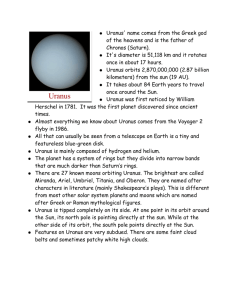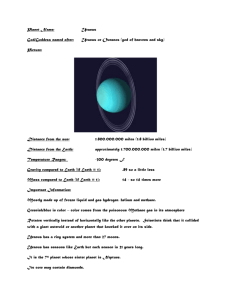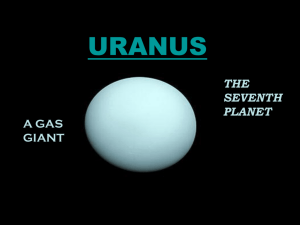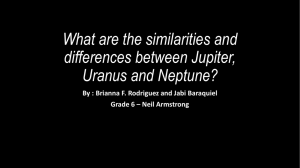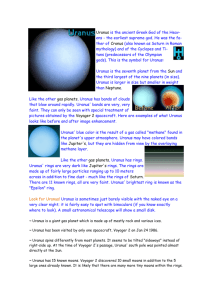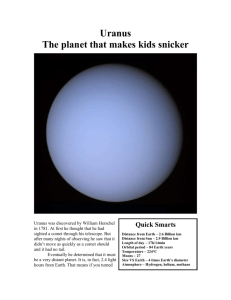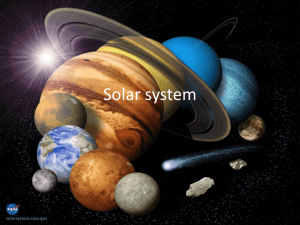Uranus
advertisement
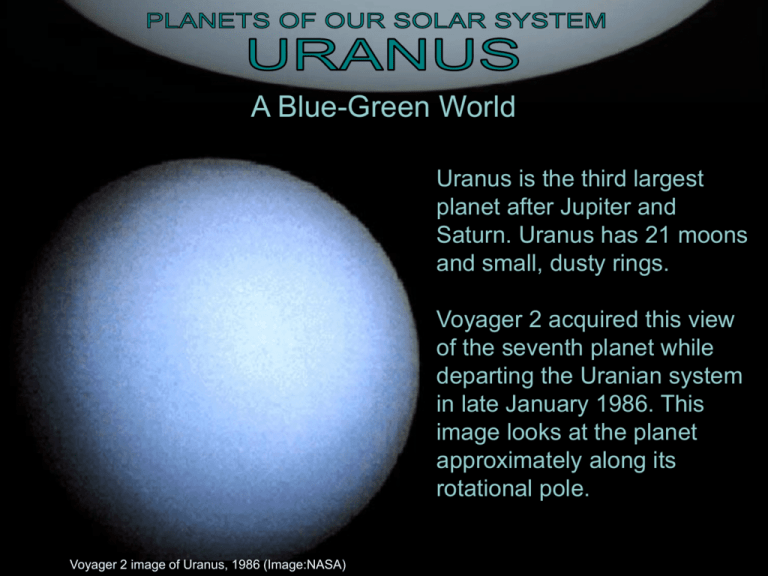
A Blue-Green World Uranus is the third largest planet after Jupiter and Saturn. Uranus has 21 moons and small, dusty rings. Voyager 2 acquired this view of the seventh planet while departing the Uranian system in late January 1986. This image looks at the planet approximately along its rotational pole. Voyager 2 image of Uranus, 1986 (Image:NASA) A Blue-Green World Uranus has a thick hydrogenmethane atmosphere. Methane causes the planet’s blue-green color. Some astronomers call Uranus and Neptune ‘ice giants’ because most of their mass is ice and some rocky material. It appears that Uranus does not have a rocky core like Jupiter and Saturn but rather that its material is more or less uniformly distributed. Hubble’s View This image, taken by Hubble, clearly shows Uranus and its rings. Uranus’ rings are smaller and dustier than those of Saturn, and will eventually dissipate. Image: NASA Deep exposure of Uranus taken with the Hubble Space Telescope reveal two small moons and two faint rings. All orbit outside of Uranus's previously known (main) ring system, but interior to the large, classical moons. Dusty Rings This image reveals many broad lanes of dust surrounding the 9 main rings of Uranus. It was taken by Voyager 2 looking back toward the sun through the ring system. Tipsy? Uranus moves around the Sun with its rotation axis is perpendicular to its orbit around the sun. It is thought that a planet-sized body hit Uranus early in its history, “tipping” it over. Because of this, Uranus’ seasons last over 20 years! Earth Uranus Distance from Sun 1.7 Billion Miles 93 Million Miles Diameter 32,000 Miles 7926 Miles Length of Year 84 Earth Years 365.25 Days Length of Day 17.24 hours 23 hours 56 minutes Gravity .89 that of Earth 2.66 times that of Mars Temperature Average -319 degrees F Average 57 degrees F Number of Moons 27 1 George’s Star • Uranus was discovered by William Herschel, the British royal astronomer, in 1781. • Herschel thought the planet was a comet at first! • He tried to name it “George’s Star” after King George. God of the Sky The name "Uranus" was eventually proposed in order to conform with the other planetary names from classical mythology. The name didn't come into common use until 1850. To the ancient Greeks, Uranus was god of the sky and heavens. Missions Only one spacecraft has visited Uranus. On Jan. 24, 1986 Voyager 2 passed within 50,600 miles. Voyager 2 radioed images and scientific data on the planet, its moons, rings, atmosphere, interior and the magnetic environment surrounding Uranus. Uranus’ Moons Miranda Ariel Umbriel Titania Oberon Uranus has 5 medium-sized moons and 21 smaller moons. The five main satellites are Miranda, Ariel, Umbriel, Tatania and Oberon. Miranda Uranus’ moon Miranda has a strange fractured appearance, as if it was shattered then put back together. The high cliffs and winding valleys of the moon may indicate that Miranda was larger in the past and shrank to its current size. Titania Picture of Titania taken by Voyager 2. Titania is 1600 kilometers in diameter. An artists view, this montage of images of the Uranian system was prepared from an assemblage of images taken by the Voyager 2 spacecraft during its Uranus encounter in January 1986.
